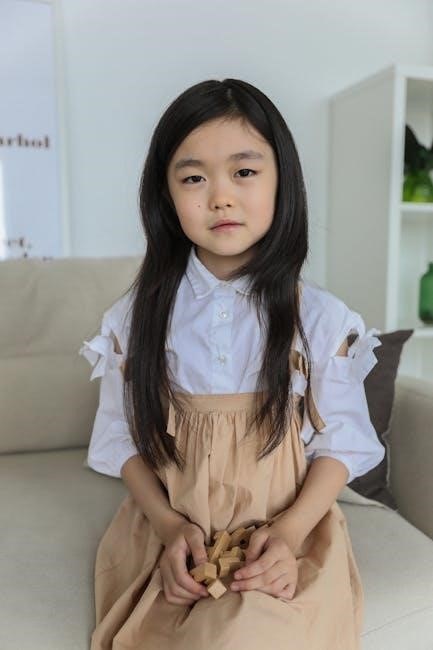Discover the essence of timeless elegance with The Little Guides to Style, a luxurious collection exploring the history and evolution of four iconic fashion houses—Chanel, Dior, Gucci, and Prada. Each book delves into their origins, key designs, and lasting influence on modern fashion, offering a comprehensive journey through the world of haute couture. This exquisite set is a must-have for every fashion enthusiast.
Overview of the Collection
The Little Guides to Style is a meticulously curated collection of four pocket-sized books, each dedicated to a legendary fashion house: Chanel, Dior, Gucci, and Prada. These books are nestled in a luxurious box set, making it a covetable addition to any fashion lover’s library. Authored by esteemed writers, including Emma Baxter-Wright, Karen Homer, and Laia Farran Graves, the collection offers a detailed exploration of each brand’s history, evolution, and iconic designs. From Chanel’s timeless tweed suits to Dior’s revolutionary “New Look,” Gucci’s bold experimentation, and Prada’s minimalist sophistication, the guides capture the essence of haute couture. Featuring hundreds of exquisite images, these books provide a visual and textual journey through the milestones of each house. Perfect as a gift or a personal treasure, The Little Guides to Style is a celebration of elegance, creativity, and the enduring legacy of these fashion icons.
The Concept Behind the Guides
The concept of The Little Guides to Style lies in their ability to distill the essence of four iconic fashion houses into concise, accessible narratives. These pocket-sized books are designed to be both informative and visually stunning, appealing to fashion enthusiasts and newcomers alike. The idea is to provide a deeper understanding of each brand’s DNA, tracing their journeys from humble beginnings to global acclaim. By focusing on key designs, pivotal moments, and the philosophies of their founders, the guides offer insights into what makes these houses timeless. The use of high-quality imagery and expert storytelling ensures that each guide is not only educational but also a pleasure to explore. This approach makes The Little Guides to Style a unique resource for anyone seeking to understand the foundation of modern fashion and the enduring influence of these legendary brands.

Historical Background of the Fashion Icons

Dive into the fascinating histories of Chanel, Dior, Gucci, and Prada through The Little Guides to Style. Each book traces the origins, evolution, and enduring legacy of these iconic fashion houses, revealing their cultural and historical significance.
The Story of Chanel
Coco Chanel, a trailblazer in fashion, revolutionized women’s style in the 1920s with her groundbreaking designs. Born in 1883, Chanel rose from humble beginnings to become a global icon, transforming fashion with her modernist approach. Her introduction of the “little black dress” and the Chanel suit liberated women from restrictive clothing, embracing simplicity and freedom. The House of Chanel, founded in 1910, became synonymous with timeless elegance, blending French sophistication with a rebellious spirit.
Chanel’s influence extended beyond clothing to perfumery, with the iconic No. 5 fragrance becoming a symbol of luxury. The Little Guides to Style explores her journey, highlighting how she redefined fashion and empowered women through her creations. Chanel’s legacy endures, inspiring generations with her innovative vision and unwavering commitment to female independence.
The Evolution of Dior
Founded in 1946 by Christian Dior, the House of Dior quickly became a symbol of luxury and femininity. Dior’s revolutionary ‘New Look’ collection in 1947 transformed post-war fashion, emphasizing opulent fabrics, tailored suits, and full skirts. This era marked the beginning of Dior’s reign as a leader in haute couture, blending elegance with modernity.
Over the decades, Dior evolved under visionary designers like Yves Saint Laurent, who introduced edgier, youth-oriented styles, and Marc Bohan, who maintained the house’s classic appeal. The 1980s saw the rise of Gianfranco Ferré, known for his dramatic silhouettes, followed by John Galliano’s theatrical designs. Today, under Maria Grazia Chiuri, Dior continues to blend tradition with contemporary values, championing women’s empowerment. The Little Guides to Style captures Dior’s journey, highlighting its enduring influence on fashion and culture.

Gucci’s Rise to Fame
Gucci’s journey to global prominence began in 1921 when Guccio Gucci founded the House of Gucci in Florence, Italy, starting with high-quality leather goods. The brand’s breakthrough came in the 1950s with the iconic Bamboo handbag, a design that remains timeless. By the 1960s, Gucci’s logo became synonymous with luxury, and its products were sought after by Hollywood stars and royalty.
The 1990s marked a turning point under Tom Ford’s creative direction, as Gucci embraced bold, provocative designs that redefined modern fashion. Today, under Alessandro Michele, Gucci continues to blend its rich heritage with contemporary eclectic styles, captivating audiences worldwide. The Little Guides to Style series delves into Gucci’s fascinating evolution, highlighting its ability to adapt while maintaining its status as a symbol of Italian craftsmanship and innovation. This legacy ensures Gucci’s enduring influence on global fashion and culture.
Prada’s Journey in Fashion
Prada’s story began in 1913 when Mario and Martino Prada opened a leather goods shop in Milan, Italy. Initially known for crafting exceptional trunks and handbags, the brand gained recognition for its timeless sophistication. The 1980s marked a pivotal era with the introduction of the iconic nylon backpack, which redefined practical luxury. Under the creative direction of Miuccia Prada, the granddaughter of Mario, the house embraced a minimalist yet intellectual approach, blending tradition with modernity. Prada’s designs, often characterized by clean lines and innovative materials, have become symbols of understated elegance. The Little Guides to Style series captures Prada’s evolution, highlighting its commitment to craftsmanship and its ability to redefine fashion while staying true to its heritage. Today, Prada remains a beacon of sophistication, influencing contemporary style with its unique blend of simplicity and avant-garde thinking.

Key Looks and Style Definers
From Chanel’s tweed suits to Dior’s iconic silhouettes, Gucci’s bold motifs, and Prada’s minimalist designs, these fashion houses have defined style through timeless pieces. The Little Guides to Style reveal their signature looks.
Chanel’s Timeless Designs
Coco Chanel revolutionized fashion with her groundbreaking designs, transforming women’s wardrobes by introducing a liberated, modernist approach. The iconic tweed suit, little black dress, and No. 5 perfume became symbols of timeless elegance. Her designs emphasized simplicity, comfort, and empowerment, breaking free from the constraints of corseted fashion. The Little Book of Chanel chronicles her journey, highlighting how her innovations continue to influence contemporary style. Chanel’s legacy endures as a beacon of sophistication and feminity, proving that true style transcends time.
Dior’s Iconic Silhouettes
Christian Dior’s revolutionary “New Look” collection in 1947 redefined women’s fashion, introducing structured, feminine silhouettes that captivated the world. The iconic Dior look, characterized by tailored suits, full skirts, and luxurious fabrics, became a symbol of elegance and sophistication. The Little Book of Dior explores how the house maintained its reputation for opulence and refinement through the decades. From Yves Saint Laurent’s bold reinterpretations to John Galliano’s theatrical designs and Maria Grazia Chiuri’s modern feminist approach, Dior’s silhouettes have evolved while staying true to the founder’s vision. The brand’s ability to blend tradition with innovation ensures its continued influence on contemporary fashion, making it a cornerstone of haute couture.

Gucci’s Bold Aesthetics
Gucci’s Bold Aesthetics have redefined luxury fashion with their eclectic and daring designs. Under Tom Ford’s creative direction in the 1990s, Gucci embraced a sexy, bold style that captivated the world. The brand’s iconic logo became synonymous with high-end fashion, and its collections often featured vibrant patterns and striking silhouettes that broke traditional norms. In recent years, Alessandro Michele has brought a new wave of boldness, blending vintage romance with contemporary androgyny. This shift has further cemented Gucci’s reputation for pushing boundaries in fashion. The Little Book of Gucci delves into the brand’s transformative journey, highlighting its most iconic looks and the visionary minds behind them. Gucci’s ability to merge bold creativity with timeless elegance continues to inspire modern fashion, making it a central figure in the industry’s evolution.
Prada’s Minimalist Chic
Prada’s Minimalist Chic is a masterclass in understated elegance and sophistication. Known for its clean lines, neutral tones, and functional designs, Prada has carved a niche in the fashion world by embracing simplicity as a form of luxury. The brand’s aesthetic, shaped by Miuccia Prada, revolves around stripped-down forms, high-quality materials, and subtle detailing. Iconic pieces like the nylon bag and minimalist footwear exemplify this approach, blending practicality with timeless style. Prada’s commitment to modernity and intellectual design has allowed it to stand apart from more elaborate trends, creating a unique identity that resonates with those who value discretion and refinement. The Little Book of Prada explores this philosophy, highlighting how the brand’s minimalist ethos has influenced contemporary fashion and cemented its status as a beacon of sophistication in the industry. Prada’s ability to balance restraint with innovation continues to inspire fashion enthusiasts worldwide.
The Impact on Modern Fashion
The influence of these iconic fashion houses is undeniable. Their timeless designs and innovative approaches continue to shape contemporary style, inspiring designers and fashion enthusiasts alike with their enduring legacy of elegance and creativity.
How These Houses Influence Contemporary Style
The iconic fashion houses of Chanel, Dior, Gucci, and Prada have left an indelible mark on modern fashion. Their timeless designs, such as Chanel’s little black dress and Dior’s New Look silhouette, continue to inspire contemporary designers. Gucci’s bold, eclectic aesthetic has influenced a new wave of maximalist trends, while Prada’s minimalist approach remains a cornerstone of sophisticated style. These houses’ ability to blend tradition with innovation has made their influence ubiquitous, from high-end couture to ready-to-wear collections. Their designs are frequently reimagined in modern interpretations, ensuring their relevance in today’s fast-paced fashion world. The Little Guides to Style beautifully captures this enduring legacy, offering insights into how these legendary brands shape the way we dress today. Their impact is evident in every runway, magazine, and wardrobe, cementing their status as pillars of modern fashion.
The Legacy of the Little Guides to Style
The Little Guides to Style have become a cherished resource for fashion enthusiasts and historians alike, offering a detailed exploration of the world’s most renowned fashion houses. These books not only chronicle the history of Chanel, Dior, Gucci, and Prada but also highlight their enduring influence on modern style. The collection’s meticulous research and stunning visuals make it a timeless reference for anyone passionate about fashion; By preserving the stories of these iconic brands, The Little Guides to Style ensure that their legacies continue to inspire future generations of designers and aficionados. This luxurious set is more than just a collection of books—it’s a celebration of fashion’s rich history and its ongoing impact on culture and identity. The guides’ ability to blend historical depth with contemporary relevance solidifies their place as a cornerstone of fashion literature.